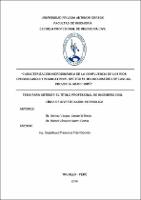Mostrar el registro sencillo del ítem
Caracterización hidrodinámica de la confluencia de los ríos Chuquillanqui y Huancay en el sector El Molino - distrito de Cascas - provincia Gran Chimú
| dc.contributor.advisor | Sagástegui Plasencia, Fidel Germán | |
| dc.contributor.author | Gómez Vargas, Llercin Wilfredo | |
| dc.contributor.author | Rázuri Vásquez, Karen Gisela | |
| dc.creator | Gómez Vargas, Llercin Wilfredo | |
| dc.date.accessioned | 2019-03-26T08:45:11Z | |
| dc.date.available | 2019-03-26T08:45:11Z | |
| dc.date.issued | 2019 | |
| dc.identifier.uri | https://hdl.handle.net/20.500.12759/4616 | |
| dc.description.abstract | Los ríos de la costa peruana han tenido la presencia de caudales de máximas avenidas durante los últimos años, asociados al Fenómeno del niño, registrando magnitudes extraordinarias en los años 1982/83, 1997/98 y 2017 provocados por las lluvias intensas en la sierra liberteña, lo que aumentó significativamente el nivel del curso de quebradas y ríos y provocó desbordes y daños considerables en zonas agrícolas y urbanas, en el evento más reciente entre el 15 y 22 de marzo se registró por desborde de las quebradas León y San Carlos dejaron un total de 201366 personas afectadas y 3875 viviendas colapsadas. El estudio hidrodinámico planteado y realizado mediante un software de modelamiento numérico bidimensional nos ha permitido conocer las características hidráulicas de los cauces en estudio, incluso hemos evaluado instantes de tiempo críticos como, por ejemplo, las velocidades máximas que en el instante t=900 muestran un valor de 11.56m/s, la altura de tirante máximo es de 8.66m en el instante t=900, asimismo para ese instante también en la confluencia se registra un tirante en un intervalo de 1.93 a 2.88 m de altura de agua, sin embargo el tirante más grande se encuentra en la parte inicial del cauce del rio Chuquillanqui, según fuentes verbales de pobladores del lugar, estas zonas han sido empleadas como canteras de finos, con respecto a su comportamiento hidráulico, se observa la formación de turbulencias en la parte de aguas debajo de la confluencia, además de existir erosión en esa zona con una profundidad de 4.11m, también se ha registrado que el rio sale de cauce natural, llegando a inundar terrenos de cultivo colindantes, con un tirante de hasta 1.93m de altura, esto nos pone en alerta ya que significa una gran pérdida económica para el sector agrario. Finalmente, el análisis de resultados y su discusión nos muestran tirantes de agua por encima de los normales por encima de los dos metros en máximas avenidas incluyendo transporte de materiales. | es_PE |
| dc.description.abstract | The rivers of the Peruvian coast have had the presence of flows of maximum avenues during the last years, associated to the Phenomenon of the child, registering extraordinary magnitudes in the years 1982/83, 1997/98 and 2017 caused by the intense rains in the sierra liberteña , which significantly increased the level of the course of streams and rivers and caused considerable overflows and damages in agricultural and urban areas, in the most recent event between March 15 and 22 was recorded by overflow of streams Leon and San Carlos left a total of 201366 people affected and 3875 homes collapsed. The hydrodynamic study proposed and carried out using a two-dimensional numerical modeling software has allowed us to know the hydraulic characteristics of the channels under study, we have even evaluated critical time instants such as, for example, the maximum speeds that at time t = 900 show a value of 11.56m /s, the maximum tension height is 8.66m at the instant t = 900, also for that instant also at the confluence a tie is recorded in a range of 1.93 to 2.88m height of water, however The largest tether is in the initial part of the Chuquillanqui river bed, according to verbal sources of local people, these areas have been used as fine quarries, with respect to their hydraulic behavior, the formation of turbulence in the part is observed of waters below the confluence, in addition to erosion in that area with a depth of 4.11m, it has also been recorded that the river leaves natural channel, reaching flooding adjoining farmland, with a tension of up to 1.93m in height, this puts us on alert since it means a great economic loss for the agricultural sector. Finally, the analysis of results and their discussion show us water straps above the normal ones above two meters in maximum avenues including transport of materials. | en_US |
| dc.description.uri | Tesis | es_PE |
| dc.format | application/pdf | es_PE |
| dc.language.iso | spa | es_PE |
| dc.publisher | Universidad Privada Antenor Orrego - UPAO | es_PE |
| dc.relation.ispartofseries | T_ING.CIVIL_1675 | |
| dc.rights | info:eu-repo/semantics/closedAccess | es_PE |
| dc.source | Universidad Privada Antenor Orrego | es_PE |
| dc.source | Repositorio Institucional - UPAO | es_PE |
| dc.subject | Hidráulica | es_PE |
| dc.subject | Caracterización hidrodinámica | es_PE |
| dc.title | Caracterización hidrodinámica de la confluencia de los ríos Chuquillanqui y Huancay en el sector El Molino - distrito de Cascas - provincia Gran Chimú | es_PE |
| dc.type | info:eu-repo/semantics/bachelorThesis | es_PE |
| thesis.degree.level | Título Profesional | es_PE |
| thesis.degree.grantor | Universidad Privada Antenor Orrego. Facultad de Ingeniería | es_PE |
| thesis.degree.name | Ingeniero Civil | es_PE |
| thesis.degree.discipline | Ingeniería Civil | es_PE |
Ficheros en el ítem
Este ítem aparece en la(s) siguiente(s) colección(es)
-
Ingeniería Civil [1085]

